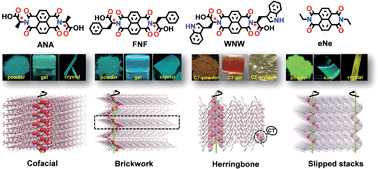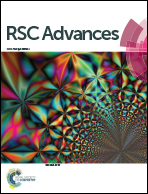Biomimetic molecular organization of naphthalene diimide in the solid state: tunable (chiro-) optical, viscoelastic and nanoscale properties†
Abstract
The interfacing of aromatic molecules with biomolecules to design functional molecular materials is a promising area of research. Intermolecular interactions determine the performance of these materials and therefore, precise control over the molecular organization is necessary to improve functional properties. Herein we describe the tunable biomimetic molecular engineering of a promising n-type organic semiconductor, naphthalene diimide (NDI), in the solid state by introducing minute structural mutations in the form of amino acids with variable Cα-functionality. For the first time we could achieve all four possible crystal packing modes, namely cofacial, brickwork, herringbone and slipped stacks of the NDI system. Furthermore, amino acid conjugated NDIs exhibit ultrasonication induced organogels with tunable visco-elastic and temperature responsive emission properties. The amino acid–NDI conjugates self-assemble into 0D nanospheres and 1D nanofibers in their gel state while the ethylamine–NDI conjugate forms 2D sheets from its solution. Photophysical studies indicated the remarkable influence of molecular ordering on the absorption and fluorescence properties of NDIs. Interestingly, the circular dichroism (CD) and X-ray diffraction (XRD) studies revealed the existence of helical ordering of NDIs in both solution and solid state. The chiral amino acids and their conformations with respect to the central NDI core are found to influence the nature of the helical organization of NDIs. Consequently, the origin of the preferential handedness in the helical organization is attributed to transcription of chiral information from the amino acid to the NDI core. On account of these unique properties, the materials derived from NDI-conjugates might find a wide range of future interdisciplinary applications from materials to biomedicine.


 Please wait while we load your content...
Please wait while we load your content...